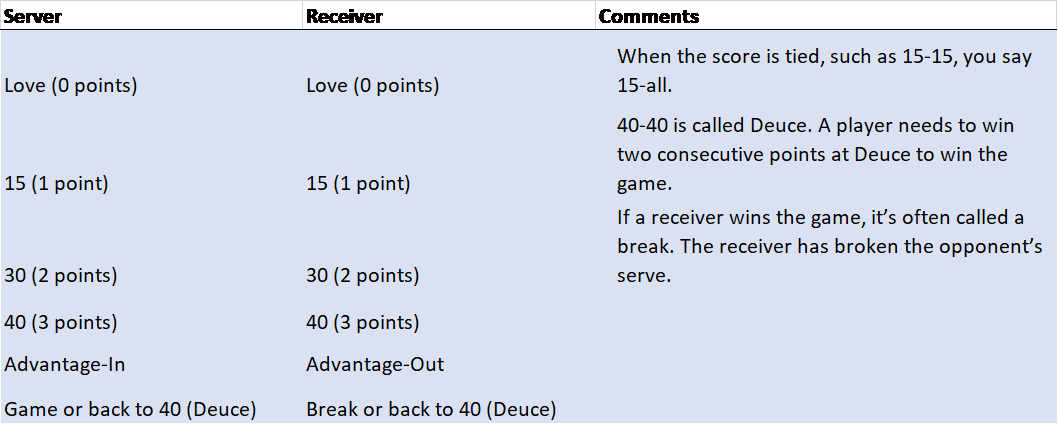Friends and family who never played tennis tell me they get confused by tennis scoring. If I didn’t grow up playing this sport, I would be confused as well because the points within games do not make sense: Love-love or love-all stand for 0-0. Then after a point is won we say love-15, followed by 15-15, 30-15, 40-15, and then game if you win having 40. Why not score it as a sequence of 1, 2, 3, and 4 points to win a game?
The origins of tennis date back to the 12th century France in a game called jeu de paume, which translates to “game of the palm.” Tennis was played with the palm of your hand until the 16th century, then racquets were introduced. But the scoring system does not have a clear origin. A great article on the origins of tennis and the origins of the scoring system can be found in the Time article.
Points & Games
A game is won if you win at least four points by a margin of two. In other words, you need to win two more points than your opponent to win a single game and at least four points in total. You call the score by first announcing the count of person who is serving the ball (starting the point) and the receiver’s points. If I am serving and lost two points and won non, then you’ll say love-30.
Here’s the breakdown:
In some competitions, games are played with no-ad scoring. The no-ad scoring rule eliminates the need to win by two points once you reach Deuce (40-all). It becomes a sudden death point – the game will end after the next point. Because the server has a natural advantage, the receiver gets to choose which side to return from at Deuce.
Sets
For most tournaments, a set is won if you reach 6 games and, like in games, win by at least a margin of two. But there are different types of sets, some modified to shorten the game to fit the different needs or requirements of specific events.
Tiebreak set. Tiebreak sets, considered as regular sets, are the most common played. The format is structured so you play a seven point tiebreaker if you reach 6-all. A tiebreaker is played until a player wins at least 7 points by a margin of two. Here the points are counted sequentially. The player who serves first will serve one point. After the first point, each player will serve two points and alternate.
Advantage set. The advantage set is played without a tiebreaker. To win the set, the player must win at least six games by a margin of two games. For example, 6-4, 7-5, 8-6, 9-7, and so on. The advantage set was used in the fifth set for Grand Slam Tournaments and resulted in some incredibly long edge-of-your seat marathons. John Isner and Nicholas Mahut played the longest match in history of tennis at the 2010 Wimbledon. Isner won the 5th set 70 to 68 — the match was 11 hours and 5 minutes!
8-game pro set. An 8-game pro set is considered an alternative to a full match. Instead of playing a best of two out of three set match, you play a single set, first to 8. At 7-all you play a tiebreaker. It is the format for NCAA Division I doubles and is sometimes used for junior tennis tournaments after a long rain delay forces the tournament director to shorten the matches. To be consistent with the intention of keeping 8-game pro sets as shorter alternatives to best of three set matches, 8-game sets are often played with no-ad scoring.
Short set. A short set is played until first to 5 games, full stop. At 4-all the players must play a tiebreaker to decide who wins the set. This format is generally for 10 & under tennis and or special events that require shortened matches. Like 8-game pro sets, short sets are also generally played with no-ad scoring.
Matches
By now you may have deduced that typical matches are played best of two out of three tiebreak sets. In some instances, tournaments will institute a 10-point tiebreaker as replacement for the third set. This happens more often in junior tennis competitions, generally in the younger divisions such as 12’s and 10 & under. However, some college tennis events will require a 10-point tiebreaker in lieu of a third regular set.
At the four Grand Slam championships, the players in the men’s division are required to win three out of five possible tiebreak sets to win the match. In the past, some of the Grand Slam events required men’s division players to complete the fifth set with an advantage set. However, as of this year, the Grand Slam Board elected to remove the advantage set and put a rule that players must play a ten-point tiebreaker if they reach 6 games all in the deciding set.


